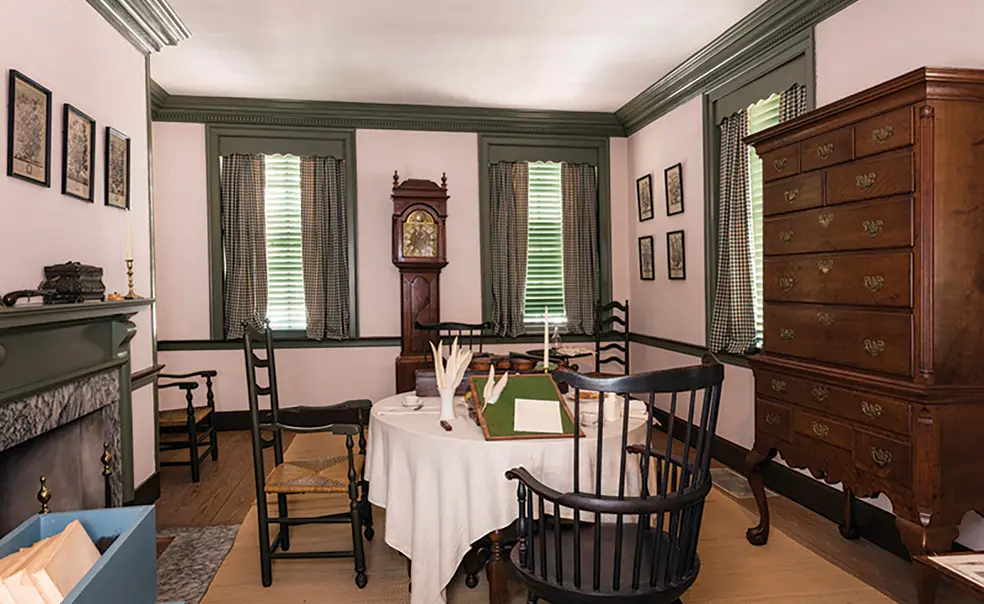African American History Taking a New View of the Declaration of Independence
While the stories of the Founding Fathers and their roles in creating the United States are well known, they weren’t the only people shaping history. Robert Hemmings, Thomas Jefferson’s valet and trained barber, was one of them. And despite eventually being the first enslaved person freed by Jefferson, he’s largely been in the background of American history. A visual record of him doesn’t even exist.
In “The Descendants of Monticello,” a new exhibit that opened June 24 at Declaration House in Philadelphia, where Jefferson wrote the Declaration of Independence in 1776, artist Sonya Clark aims to change that by elevating Hemmings’ story, and in the process, those of other enslaved people who were both central to, as well as witnesses to, the forming of this country.
“The house itself is a portal that can really open up, not just about this particular story of Robert Hemmings, but really the story of America,” says Anna Arabindan-Kesson, co-curator of the exhibit and associate professor of art and archaeology and African American studies at Princeton.
At Declaration House, which is part of the Independence National Historical Park in Philadelphia, Jefferson was not alone. Hemmings, who was 14 at the time, was with him, and attended to Jefferson’s personal needs, such as helping him dress and making sure he was not disturbed while working. Hemmings stayed with him until 1784, when Jefferson left for France.
Despite having a front row seat to history, Hemmings has been largely ignored as part of that story. Clark and Monument Lab, a nonprofit public art and history studio based in Philadelphia, decided to change that.
They started by reaching out to Jefferson’s Monticello, where Niya Bates, a descendant of individuals who were enslaved by Jefferson's family and a current Princeton Ph.D. student in history, served as the director of African American history and the Getting Word African American Oral History Project.
“While we do have a lot of documentary evidence about Hemmings, there’s just not enough meat there to really run with,” says Bates, who is a student of Arabindan-Kesson. For example, historians know that Hemmings bought his freedom by 1799 because that’s the first year he appeared on Richmond’s tax rolls.
Through Getting Word, Clark took portrait photographs of more than 400 members of the descendant community and used images of their eyes for the exhibit, to make a projection of eyes opening and closing to create a different kind of experience than if it was just images and artifacts.
“In that way, they could stand in the gap where we had those holes in the archival evidence about Robert Hemmings,” Bates says.
These contemporary video portraits of living descendants are juxtaposed with eyes drawn from photographs of descendants found in Monticello’s archives.
“It’s not an exhibit where people go into the building and walk around,” says Arabindan-Kesson. Instead, the projections “pull a viewer in because you’re being looked at. You’re an active participant. You’re a witness.”
The exhibit is also a way of getting people to interrogate the history they’ve been taught, and look for who is missing from the story — people like Hemmings, and his sister Sally Hemings, who bore several of Jefferson’s children.
Bates adds that this project is also unique in which organizations have come together to make it happen: a National Park historic site, a historic house museum, a nonprofit, and the descendent community. They hope by focusing on those who weren’t founders, it will force viewers to think about the concepts of democracy, liberty, and what it means to be an American citizen, she says.
The exhibition runs through early September. Arabindan-Kesson and Bates are also working with Yolonda Wisher, senior curator at Monument Lab, on a book about the exhibit and Hemmings that will be published in time for the U.S.’s 250th anniversary in 2026.












No responses yet